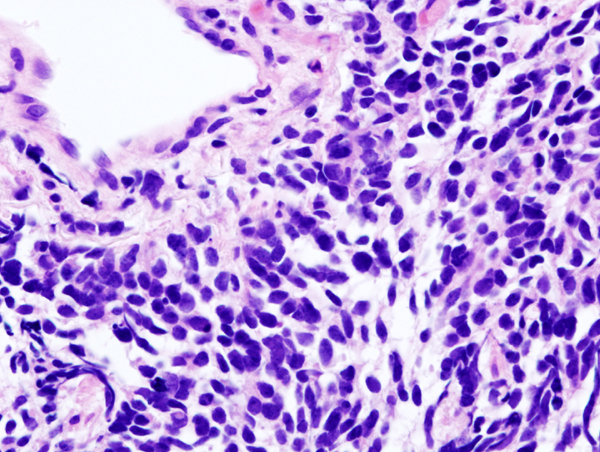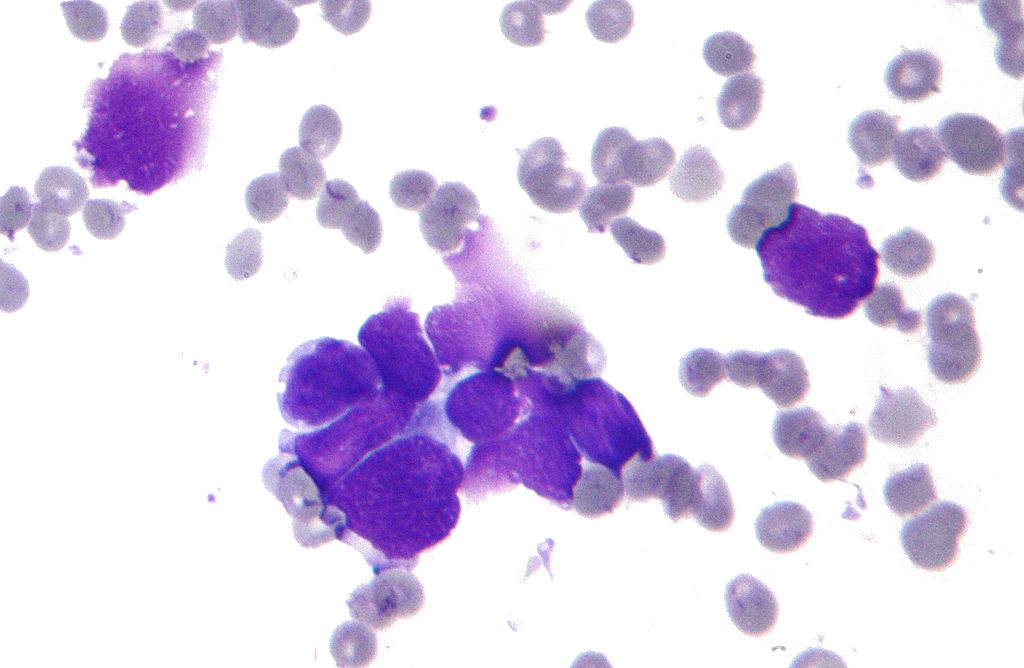Small cell carcinoma of the lung diagnostic study of choice: Difference between revisions
No edit summary |
|||
| Line 5: | Line 5: | ||
== Diagnostic Study of Choice == | == Diagnostic Study of Choice == | ||
===Overview=== | |||
Chest [[CT scan]], preferably with [[intravenous]] [[contrast]] administration, may be helpful in the [[diagnosis]] of small cell carcinoma. Findings on [[CT scan]] suggestive of small cell carcinoma include [[Hilum|hilar]] mass, [[mediastinal]] involvement, numerous [[lymphadenopathy]], direct infiltration of adjacent structures, [[necrosis]] and [[hemorrhage]]. Small cell carcinoma of the lung is the most common cause of [[SVC obstruction]], due to both compression/[[thrombosis]] and/or direct infiltration 2. All patients with confirmed diagnosis of SCLC by [[histopathological]] findings should undergo a [[CT scan]] of the [[abdomen]] for staging purposes. [[Computed tomography|CT scan]] of the [[abdomen]] helps identify [[metastasis]] to organs, such as the [[liver]] or the [[adrenal glands]]. Brain imaging is also mandatory for staging; however, brain [[MRI]] is preferred over brain [[CT scan]] due to its superior [[sensitivity]] for the detection of brain [[metastasis]]. In addition, when limited stage small cell lung cancer is suspected, [[PET]] CT scan should be performed. | |||
===== | ==CT== | ||
Chest [[Computed tomography|CT scan]], preferably with [[intravenous]] [[contrast]] administration, may be helpful in the [[diagnosis]] of small cell carcinoma. Findings on [[Computed tomography|CT scan]] suggestive of small cell carcinoma include:<ref name="NCCN">[http://www.nccn.org/professionals/physician_gls/f_guidelines_nojava.asp NCCN Clinical Practice Guidelines in Oncology. Small Cell Lung Cancer, version 2.2014] </ref> | |||
*[[Hilum|Hilar]] mass | |||
*[[Mediastinum|Mediastinal]] involvement | |||
*Numerous [[lymphadenopathy]] | |||
*Direct infiltration of adjacent structures | |||
*[[Necrosis]] | |||
*[[Hemorrhage]] | |||
*The most common cause of [[SVC obstruction]] is SCLC, because of both compression or [[thrombosis]] and or direct infiltration. | |||
*[[CT-scans|CT]] is used to stage small cell lung cancer. | |||
*CT scan of the abdomen helps identify [[metastasis]] to organs, such as the [[liver]] or the [[adrenal glands]]. | |||
*[[Brain]] imaging is also mandatory for staging however a brain [[MRI]] is preferred over brain [[CT scan]] due to its superior [[sensitivity]] for the detection of [[brain]] [[metastasis]]. | |||
*[[PET]] [[CT-scans|CT]] scan should be performed if limited stage small cell lung cancer is suspected. | |||
=== | ==Microscopic Pathology== | ||
In small cell lung cancer, the tumor cells are small and round, but they can sometimes be ovoid or spindle shaped. They have a scant [[cytoplasm]] with a high mitotic count and a hyperchromatic [[nuclei]]. Nearly all small cell lung cancer are immunoreactive for [[keratin]], [[thyroid transcription factor 1]], and epithelial membrane antigen. Neuroendocrine and neural differentiation result in the expression of molecules like dopa decarboxylase, [[calcitonin]], neuron-specific [[enolase]], [[chromogranin A]], [[CD56]] (also known as nucleosomal histone kinase 1 or neural-cell adhesion molecule), gastrin-releasing peptide, and [[insulin-like growth factor 1]]. One or more markers of neuroendocrine differentiation can be found in approximately 75% of small cell lung cancer.<ref name="NCI">National Cancer Institute: PDQ® Small Cell Lung Cancer Treatment. Bethesda, MD: National Cancer Institute. Available at: http://www.cancer.gov/cancertopics/pdq/treatment/small-cell-lung/healthprofessional.</ref> | |||
{| | |||
|- | {| class="wikitable" | ||
|[[Image:Lung small cell carcinoma (1) by core needle biopsy.jpg|300px|thumb| Histopathologic image of small cell carcinoma of the lung. CT-guided core needle biopsy. H & E stain.By No machine-readable author provided. KGH assumed (based on copyright claims),via Wikimedia Commons <ref>href="http://www.gnu.org/copyleft/fdl.html">GFDL<nowiki></a></nowiki> or <nowiki><a href="http://creativecommons.org/licenses/by-sa/3.0/">CC-BY-SA-3.0</a></nowiki>], <nowiki><a href="https://commons.wikimedia.org/wiki/File%3ALung_small_cell_carcinoma_(1)_by_core_needle_biopsy.jpg"></nowiki></ref>]] | |||
|[[Image:Lung small cell cancer 01.jpeg|300px|thumb| Micrograph of a small-cell carcinoma of the lung showing cells with nuclear moulding, minimal amount of cytoplasm and stippled chromatin. FNA specimen. Field stain.By No machine-readable author provided. KGH assumed (based on copyright claims), via Wikimedia Commons <ref>href="http://www.gnu.org/copyleft/fdl.html">GFDL ="http://creativecommons.org/licenses/by-sa/3.0/">CC-BY-SA-3.0], href="https://commons.wikimedia.org/wiki/File%3ALung_small_cell_carcinoma_(1)_by_core_needle_biopsy.jpg"></ref>]] | |||
|- [[Image:Lung small cell cancer 03.jpeg|300px|thumb| Anaplastic (microcellular, oat cell) carcinoma from the lung., via Wikimedia Commons <ref>href="https://commons.wikimedia.org/wiki/File:Carcinoma_microcellulare_oatcell_carcinoma_or_anaplastic_carcinoma_(lung)H%26E_magn_200x.jpg</ref>]] | |||
|- | | | ||
| | |||
|- | |||
| | |||
| | |||
|} | |} | ||
==References== | ==References== | ||
Revision as of 18:38, 30 April 2018
|
Small Cell Carcinoma of the Lung Microchapters |
|
Differentiating Small Cell Carcinoma of the Lung from other Diseases |
|---|
|
Diagnosis |
|
Treatment |
|
Case Studies |
|
Small cell carcinoma of the lung diagnostic study of choice On the Web |
|
American Roentgen Ray Society Images of Small cell carcinoma of the lung diagnostic study of choice |
|
FDA on Small cell carcinoma of the lung diagnostic study of choice |
|
CDC on Small cell carcinoma of the lung diagnostic study of choice |
|
Small cell carcinoma of the lung diagnostic study of choice in the news |
|
Blogs on Small cell carcinoma of the lung diagnostic study of choice |
|
Directions to Hospitals Treating Small cell carcinoma of the lung |
|
Risk calculators and risk factors for Small cell carcinoma of the lung diagnostic study of choice |
Editor-In-Chief: C. Michael Gibson, M.S., M.D. [1]; Associate Editor(s)-in-Chief:
Overview
Diagnostic Study of Choice
Overview
Chest CT scan, preferably with intravenous contrast administration, may be helpful in the diagnosis of small cell carcinoma. Findings on CT scan suggestive of small cell carcinoma include hilar mass, mediastinal involvement, numerous lymphadenopathy, direct infiltration of adjacent structures, necrosis and hemorrhage. Small cell carcinoma of the lung is the most common cause of SVC obstruction, due to both compression/thrombosis and/or direct infiltration 2. All patients with confirmed diagnosis of SCLC by histopathological findings should undergo a CT scan of the abdomen for staging purposes. CT scan of the abdomen helps identify metastasis to organs, such as the liver or the adrenal glands. Brain imaging is also mandatory for staging; however, brain MRI is preferred over brain CT scan due to its superior sensitivity for the detection of brain metastasis. In addition, when limited stage small cell lung cancer is suspected, PET CT scan should be performed.
CT
Chest CT scan, preferably with intravenous contrast administration, may be helpful in the diagnosis of small cell carcinoma. Findings on CT scan suggestive of small cell carcinoma include:[1]
- Hilar mass
- Mediastinal involvement
- Numerous lymphadenopathy
- Direct infiltration of adjacent structures
- Necrosis
- Hemorrhage
- The most common cause of SVC obstruction is SCLC, because of both compression or thrombosis and or direct infiltration.
- CT is used to stage small cell lung cancer.
- CT scan of the abdomen helps identify metastasis to organs, such as the liver or the adrenal glands.
- Brain imaging is also mandatory for staging however a brain MRI is preferred over brain CT scan due to its superior sensitivity for the detection of brain metastasis.
- PET CT scan should be performed if limited stage small cell lung cancer is suspected.
Microscopic Pathology
In small cell lung cancer, the tumor cells are small and round, but they can sometimes be ovoid or spindle shaped. They have a scant cytoplasm with a high mitotic count and a hyperchromatic nuclei. Nearly all small cell lung cancer are immunoreactive for keratin, thyroid transcription factor 1, and epithelial membrane antigen. Neuroendocrine and neural differentiation result in the expression of molecules like dopa decarboxylase, calcitonin, neuron-specific enolase, chromogranin A, CD56 (also known as nucleosomal histone kinase 1 or neural-cell adhesion molecule), gastrin-releasing peptide, and insulin-like growth factor 1. One or more markers of neuroendocrine differentiation can be found in approximately 75% of small cell lung cancer.[2]
 |
 |
References
- ↑ NCCN Clinical Practice Guidelines in Oncology. Small Cell Lung Cancer, version 2.2014
- ↑ National Cancer Institute: PDQ® Small Cell Lung Cancer Treatment. Bethesda, MD: National Cancer Institute. Available at: http://www.cancer.gov/cancertopics/pdq/treatment/small-cell-lung/healthprofessional.
- ↑ href="http://www.gnu.org/copyleft/fdl.html">GFDL</a> or <a href="http://creativecommons.org/licenses/by-sa/3.0/">CC-BY-SA-3.0</a>], <a href="https://commons.wikimedia.org/wiki/File%3ALung_small_cell_carcinoma_(1)_by_core_needle_biopsy.jpg">
- ↑ href="http://www.gnu.org/copyleft/fdl.html">GFDL ="http://creativecommons.org/licenses/by-sa/3.0/">CC-BY-SA-3.0], href="https://commons.wikimedia.org/wiki/File%3ALung_small_cell_carcinoma_(1)_by_core_needle_biopsy.jpg">
- ↑ href="https://commons.wikimedia.org/wiki/File:Carcinoma_microcellulare_oatcell_carcinoma_or_anaplastic_carcinoma_(lung)H%26E_magn_200x.jpg